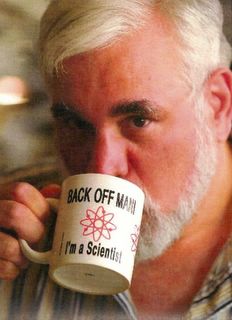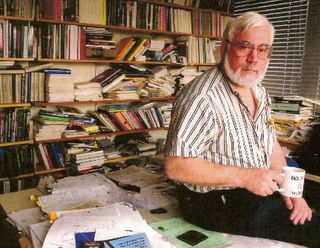 By David Abel | Globe Staff | 6/12/2000
By David Abel | Globe Staff | 6/12/2000CAMBRIDGE - A loud, hammering voice seeps out of the small office, and the gray-bearded man shouting into the phone won't let his point escape the caller: "I'm talking about scientific fraud, government waste, and the abuse of power."
From behind the clutter of model rockets and dog-eared scientific manuals devouring his desk, one of the nation's leading dissidents of pricey Pentagon programs slides back in his chair and sips from a mug inscribed with a message, "Back off Man! I'm a Scientist."
Nearly a decade ago, Theodore A. Postol, MIT physicist, missile expert, and professor of national security studies, gained acclaim in scientific circles and disdain in the Defense Department after debunking the "success" of Raytheon Corp.'s Patriot missile during the Gulf War. His analysis prompted the Army and Raytheon to reduce Patriot's claimed success rate by half and many to question whether the defensive weapon left more damage than Iraq's Scud missiles.
Now, Postol, once one of the military's top scientific advisers, is at it again. He believes he has the facts to prove that the $60 billion program to shoot down hostile missiles launched against the United States has a critical flaw: It won't work.
In the process, Postol may have helped redefine the intelligentsia's role in forming the nation's foreign policy. At last week's summit in Moscow, Russian president Vladimir Putin appeared to adopt a plan proposed by Postol that could substantially alter the terms of a US national missile defense, prevent another arms race with Russia or China, and maintain a cornerstone arms treaty ensuring the balance of power.
"If this isn't scientific fraud, I don't know what is," he said. "And it's bad government. If I'm wrong, they should discredit me. They should show that I don't know what I'm talking about. But they can't."
Last month, Postol made headlines after a letter he wrote to the White House detailed potential pitfalls in the administration's missile-defense plan and exposed what he believes is evidence of a cover-up. Furthering his suspicions, the White house turned his letter over to the Pentagon's Ballistic Missile Defense Office, which promptly classified Postol's findings as secret, even though the letter had already been published on Russian Web sites.
The 54-year-old professor, a scientific adviser to the chief of naval operations in the 1980s who helped develop the Trident 2 missile, believes current technology is nowhere close to discriminating between a potential enemy's decoys and nuclear warheads. A few balloons, he says, might be sufficient to fool the current or future crop of antimissiles.
The proof, Postol says, was recently revealed by a lawsuit filed by Nira Schwartz against her former employer, the military contractor TRW. Schwartz, a senior TRW engineer, contends that the contractor fired her after she uncovered fraudulent performance reports. TRW, contracted by Boeing Co. to build the "kill vehicle" (the antimissile's 120-pound homing device), denies the allegations.
According to his analysis of
 documents from the lawsuit, Postol says TRW's own flight-test data found the decoys and warheads indistinguishable. Moreover, Postol now believes the Pentagon is rigging the tests to ensure success. After a 1997 test of the antimissile revealed it couldn't effectively distinguish decoys from warheads, he says, the Pentagon stopped using decoys that could seriously challenge the interceptor.
documents from the lawsuit, Postol says TRW's own flight-test data found the decoys and warheads indistinguishable. Moreover, Postol now believes the Pentagon is rigging the tests to ensure success. After a 1997 test of the antimissile revealed it couldn't effectively distinguish decoys from warheads, he says, the Pentagon stopped using decoys that could seriously challenge the interceptor.In the draft of another letter he plans to send to Clinton administration officials, Postol says that other government documents he obtained prove the ballistic-missile office has significantly reduced the difficulty of the next 14 tests planned before the antimissile would be deployed in 2005.
Pentagon officials have yet to respond to the specific allegations of fraud Postol detailed in his May letter to the White House. But they dismiss his criticism as based on limited and old data and on plans still in the making.
"Dr. Postol is not considering all the capabilities of what we call our `system of systems,"' said Lt. Col. Rick Lehner, a spokesman for the Pentagon's National Missile Defense program. "The information on which he bases his claims is incomplete and his conclusions are wrong."
Lehrer believes Postol's analysis doesn't account for the role advanced radars would play in ferreting warheads from decoys. And the most up-to-date kill vehicle, a weapon designed by Raytheon, uses more advanced technology than the one TRW built for Boeing, which lost the contract competition.
But neither Lehrer nor other Pentagon officials would explain the technological differences. "For obvious security reasons, we can't discuss the capability of the system," he said. "There's absolutely no way to get into great detail without spilling the beans to potential adversaries."
As more information leaks out of the Pentagon, those words sound like a cover-up to many scientists.
"It's just another whitewash," said Schwartz, who has joined Postol and others in calling for a board of independent scientists to review the data before President Clinton decides whether to deploy the system. "The mathematical tools used to process the data will not make a miracle. Math is just a tool, not magic. Right now, there's no way to differentiate the decoys."
In the fall, relying on Pentagon reports, the president will decide whether to proceed with the Pentagon's plans for a limited national missile defense, a system of at least 100 interceptors based in Alaska.
Yet, the decision relies on more than science. Democrats, long pigeonholed by Republicans as "wimps" on defense, know they risk appearing weak in an election year if they don't press on. For their part, most Republicans - including George W. Bush - believe the United States should field a more extensive national missile defense than the Clinton administration's. They want space-based and sea-based weapons in addition to the Alaska interceptors.
"Ted is evidently in the business of telling the emperor he has no clothes; unfortunately, the facts haven't penetrated Washington circles," said John Pike, director of space policy and military analysis at the Federation of American Scientists in Washington. "It's kind of dreadful to contemplate what's technically possible and politically acceptable."
Postol is not against the Clinton administration's missile-defense plan just because he believes it won't work. As it stands, he and many others fear the plan could lead to a new arms race with Russia and China, deflect taxpayer money from more important projects, and wreck plans to further reduce still plentiful stocks of Russian and US nuclear weapons.
And like other analysts, Postol also questions the threat of a "rogue" nation such as North Korea, Iran, or Libya amassing the technical know-how to launch a nuclear missile against the United States. "It's ludicrous to postulate such a threat from such small, underdeveloped countries," he said.
But if such a threat does arise - a 1998 commission of experts led by former Defense Secretary Donald Rumsfeld concluded North Korea and Iran could develop intercontinental ballistic missiles within five years - Postol believes there's a less expensive and more assured defense.
And it's also palatable to Russia.
The "boost-phase" idea, endorsed last week by Putin, would station antimissile-carrying warships in the waters near a hostile country. If the country launched a ballistic missile, the warships would be in a position to knock it out of the sky before the missile left the region.
"Most scientists agree that this is really the only defense that's feasible," said Robert Park, a physicist and executive director of the Washington-based American Physical Society, the nation's largest group of physicists.
Three former national security advisers - John Deutch, deputy defense secretary and CIA director under Clinton, Harold Brown, President Jimmy Carter's defense secretary, and John P. White, a deputy defense secretary under Clinton - add their cachet in support of a boost-phase defense in this summer's issue of Foreign Policy.
Shooting at a missile before it breaches the atmosphere allows a defensive system to aim at a large, flame-spewing rocket (instead of a small warhead) in a stage when it can't release decoys, proponents say. It's attractive to the Russians because the geographically specific defense wouldn't alter the balance of power or upend the 1972 antiballistic-missile treaty, which bans national missile defenses.
While Postol wasn't the first to think up a boost-phase defense, he's one of the only scientists to rigorously study its possible use. And he may have also given Russians the idea, at least one based on a joint defense.
In September, the MIT professor briefed scientists and officials on the boost-phase defense in meetings at Russia's parliament, ministries of defense and foreign affairs, and the department overseeing the country's early warning system against nuclear attack.
"Unfortunately, it appears the Russian government is listening to him more closely than the US government," said Geoffrey Forden, a military analyst at the Congressional Budget Office soon to be a senior research fellow at MIT.
Although Pentagon officials agree the boost-phase defense could be effective, they believe such a sea-based system couldn't be ready until around 2012. And they don't want to wait that long.
David Abel can be reached at dabel@globe.com. Follow him on Twitter @davabel.
Copyright, The Boston Globe

